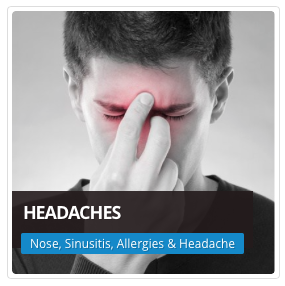For as long as I can remember, I’ve suffered from headaches, and not just the type you get when you haven’t had enough sleep or drank a little too much the night before. These headaches were downright horrible — the kind where your head’s constantly pounding for what seems like no reason at all and no matter how much Advil, Tylenol, or Aleve you pop, the pain just doesn’t go away.
While I searched high and low for a solution to my problem, I realized something — I didn’t even really know what my problem was, so how could I expect to fix it? The thing is, not all headaches are the same, so first and foremost, you have to determine what’s causing yours so you can then choose the correct course of treatment.
When it comes to headaches, there’s two main kinds — migraine headaches and sinus headaches.
Understanding the difference:
Migraine headaches are chronic neurological disorder with a number of variable presentations. Migraines generally have a neurovascular connection and more commonly affect one side of the head. Associated symptoms may include nausea, vomiting, photophobia (sensitivity to light) or phonophobia (sensitivity to sound). Classic migraine presents with an aura, a transient visual or sensory disturbance that precedes the onset of a headache. Common migraine is not preceded by an aura.
Migraine headaches typically last from 3 hours to 3 days and are often debilitating. Chronic migraine is defined as headaches occurring more than 15 days of the month for more than 3 months. Migraines are usually hormonally influenced and are more likely to occur around menstruation.
Sinus headaches are a constant throbbing or dull headache with deep facial pain is typical of a sinus headache. Chronic inflammation in the sinuses may obstruct normal sinus drainage and circulation and cause facial pain, even in the absence of an acute infection. Environmental allergens and irritants, including smoke, chemicals and fumes, may trigger or exacerbate sinus headaches.
The maxillary sinuses are located behind the cheekbone and can cause a dull achy pain in the cheeks that may radiate to the teeth or ears. The ethmoid sinuses are located between the eyes and can cause pain that radiates to the eye area. The frontal sinuses are located in the forehead and can cause frontal headaches and pressure. The sphenoid sinuses are located in the center of the skull and can cause pain radiating to the top and back of the head.
Sinus headaches may also be accompanied by nasal drainage, fullness or pressure in the ears, or fever. Sinus headaches may be confused with migraine headaches. Unlike migraines, nausea, vomiting or photophobia (sensitivity to light) are not associated with sinus headaches.
How to treat each:

Migraine headaches:
- Initial treatment of migraine may be controlled by analgesics, such as Ibuprofen or Tylenol.
- When analgesics are ineffective, Triptans or Ergotamines may be used.
- Magnesium deficiency may worsen the condition. True autonomic magnesium deficiency is difficult to test with blood magnesium levels because most of the body’s Magnesium is intracellular and not accurately assayed with blood testing. All patients should be started on Magnesium oxide or Magnesium citrate 400mg twice a day.
- Antidepressants that work to inhibit serotonin may be used to treat the serotonin imbalance commonly seen with migraines.
- Beta-blockers such as metoprolol and propranolol or topiramate are most useful for migraine prophylaxis
- Botulinum toxin chemo-denervation has been helpful to treat chronic migraine.
- Surgical Myectomy may be performed in patients who demonstrate success with Botox chemodenervation. Surgery to transect the muscle will eliminate painful muscle spasms in the forehead, temple and occipital regions
- Endoscopic resection of concha bullosa and treatment of sinus contact points
Sinus headaches:
- Avoidance of allergic or irritant triggers
- Saline sinus irrigations can help clear the sinuses
- Humidification or a steam vaporizer can restore moisture
- Nasal decongestants and mucolytics can help inflamed sinuses drain
Persistent headaches (greater than 12 weeks) despite medical therapy may indicate obstructed or narrow sinus drainage tracts and a CT scan is recommended. Balloon Sinuplasty may effectively treat blocked sinuses and reverse chronic sinus inflammation. Read more about Balloon Sinuplasty and schedule your no obligation consultation with Dr. Monica Taros about the available treatment options in NYC & NJ.




